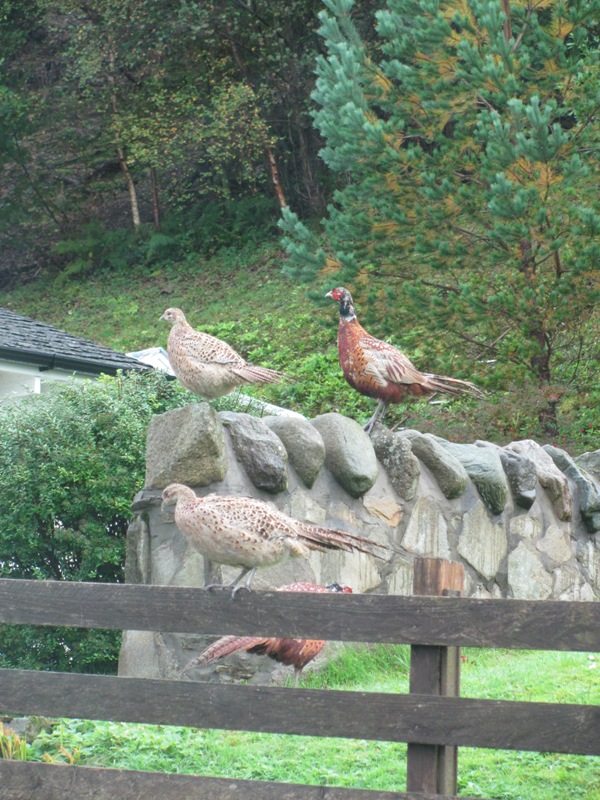On a blustery and damp day in October, we drove up to Stirling with the main intention of seeing the castle. We did have a couple of stops on the way, one for tea at a service station and also at Bannockburn just outside Stirling. There is quite some debate as to where exactly the battle took place but in a field set aside to commemorate it sits a large statue of Robert the Bruce on his horse.
Had our navigation been better, we would never have found the museum in Stirling. We saw this recent bust by Andrew Stoddart of Blind Harry there. Blind Harry, or Henry the Minstral, wrote a long poem on the life of William Wallace and there is some pretty good evidence that he was a minstral in the court of James IV, though there seems to some debate as to whether he was blind or not.
I've snaffled this picture from elsewhere on the net as I didn't actually take one myself. As we approached the castle from the town, I don't think we actually had a clear view of it from the outside at any point.
The Queen Anne Garden. Thought to have been turned into a garden in the 1400s, it was converted into a bowling green in the 1620s
A wee look over the wall seems to be a good time to tell the tale of John Damien, who was an alchemist at the court of James IV. When his experiments to make gold weren't going as he wanted he declared that he would fly to france in a chicken suit, in order the retain favour at court. In 1507, he leapt from these walls in the suit - he managed to survive and sustained only a broken leg (not counting injuries to his pride). A court rival William Dunbar seemed all to happy with his lack of success and wrote these words.
He Schewre his feddreme that was shene,
And slippit out of it full clene
And in a myre up to the ene
Among the glar did glyd
Or, to paraphrase, he slipped out of his shiney feathery coat and landed in a midden up to his eyes.
It is thought that James V may have kept a lion in this courtyard. Lions were often diplomatic gifts in those days. His father James IV had 3.
A great deal of reseach and effort has gone into restoring the Palace of James V in the castle to what it would have been like in around 1545. I was most impressed, it wasn't at all what I would have expected of the time.
The tapestries are being woven over a number of years in another building in the castle (which we visited - taking pictures of the tapestry makers wasn't allowed). Tapestry making is time consuming and very expensive as it would have been 500 years ago. They were more for display of wealth and status rather than hanging in front of windows to keep out the drafts.
One of the staff looking quite at home - I can tell you, he was very knowledgable on the history of the castle.
The ceiling of the Kings Presence Chamber, below was decorated with an estimated 56 carved, oak roundels, known as the Stirling Heads, featuring with all sorts of things; royalty, members of the court including the jester, worthy characters from history and roman emperors. In 1777 following a collapse the ceiling was taken down. Between 34 and 38 of the roundels still exist, depending on who you read and they may have come from more than one ceiling in the castle. Most are excellently displayed elsewhere in the castle but there are 3 in the museum in Edinburgh and a couple on display elsewhere in Stirling. Replicas have been crafted and painted (as they would have been back in the 16th century) and remounted on the ceiling. The effect is quite stunning.
Here are a few of the new roundels and their originals - long since lost their paint though some traces have been found on them.
Hercules and the lion.
This little chap is a Putti. Go on, read about them yourself
here though historic Scotland describes them as Renaissance imps (there are two on the ceiling.)
This one has a worrying likeness to a certain 20th century British prime minister.
If there's one advantage of rain it's rainbows.
Just outside the town, a view of the Wallace monument from the ramparts.
Painted yellow, the great hall of the castle stands out from miles away. To the modern eye it looks rather strange, jarring even, but it is pretty much how it would have looked when it was built in 1503. It is the largest medieval banqueting hall built in Scotland. In 1594 at the Baptism feast of James VI 's first son , Prince Henry, the fish course was brought in on a ship 5 meters long and 12 meters high which fired a salvo from 36 brass guns on board.
After our trip to the castle we popped into town for a cuppa and a bite to eat where we saw this statue of William Wallace (does he look like he would have half his face painted blue???) It seems appropriate to bookend this blog with the two heroes of Scottish Independence after visiting the castle where the history of Scotland pivoted in 1314.





























































